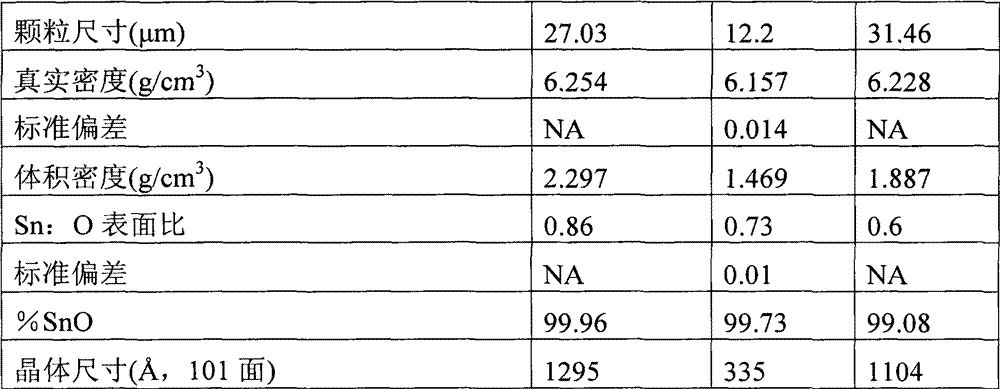Process for making sno
A composition and particle technology, applied in the field of stannous oxide preparation, can solve problems such as miscalculation and soft errors
- Summary
- Abstract
- Description
- Claims
- Application Information
AI Technical Summary
Problems solved by technology
Method used
Image
Examples
Embodiment 1
[0023] 100 g of granular tin was charged into a 5 L glass reactor equipped with a mechanical stirrer, reflux condenser and active nitrogen purge. The reactor was charged with 345 mL of water and 460.5 mL of 37% hydrochloric acid. The solution was heated to an internal temperature of 110°C and held at this temperature for 12 hours, then cooled to an internal temperature of 35°C. The resulting solution was vacuum transferred to a 22 L reactor equipped with a mechanical stirrer and reflux condenser. The solution was carefully titrated at a rate of 300 mL / min with a previously prepared solution containing 600.3 g of sodium carbonate dissolved in 2.7 L of water. During the addition of the base, stir well to dissipate any foam that develops during the initial addition. After the foaming is complete, the rest of the alkali solution is added in one portion. The solution was heated to 105°C and allowed to reflux for 3 hours, then it was cooled back to an internal temperature of 35°C...
Embodiment 2
[0025] 25 g of granular tin was charged into a glass reactor equipped with a mechanical stirrer, reflux condenser and active nitrogen purge. The reactor was charged with 85 g of water and 115 mL of 37% hydrochloric acid. The mixture was heated to 50°C and reacted at this temperature for 72 hours until the solution became colorless and transparent, then cooled to ambient temperature. The solution was transferred to a glass reactor equipped with a mechanical stir bar and reflux condenser. To this solution was added 187 g of solid potassium carbonate, taking great care during the initial addition to minimize foaming at the top of the reaction. The resulting light gray slurry was heated to 100°C and stirred for 1 hour until the solution turned black in appearance. The solution was cooled to ambient temperature and then drained from the reactor and vacuum filtered to separate the desired blue / black solid from the colorless clear liquid. The resulting wet filter cake was put into...
Embodiment 3
[0027] 1 kg of tin foil with a low alpha-radiation source was loaded into a glass reactor equipped with a mechanical stirrer, reflux condenser and active nitrogen purge. The reactor was charged with 3.42 kg of water and 6.4 kg of 37% hydrochloric acid. The resulting solution was heated from 37°C to 105°C at a rate of 0.5°C / min and then kept at 105°C for 9 hours, then cooled to 25°C. To this colorless transparent solution was carefully added a solution containing 6 kg of sodium carbonate dissolved in 27 kg of water within 30 minutes. The resulting white slurry was heated at a rate of 0.3°C / min until the internal solution temperature reached 78°C and then the solution was cooled down at a rate of -0.2°C / min. Complete the entire heating / cooling procedure within 4 hours. The resulting black suspension was drained from the reactor and sent directly to a vacuum filter tank. The resulting wet cake was washed with 1 kg of water under constant vacuum filtration conditions without ag...
PUM
| Property | Measurement | Unit |
|---|---|---|
| particle size | aaaaa | aaaaa |
Abstract
Description
Claims
Application Information
 Login to View More
Login to View More - R&D Engineer
- R&D Manager
- IP Professional
- Industry Leading Data Capabilities
- Powerful AI technology
- Patent DNA Extraction
Browse by: Latest US Patents, China's latest patents, Technical Efficacy Thesaurus, Application Domain, Technology Topic, Popular Technical Reports.
© 2024 PatSnap. All rights reserved.Legal|Privacy policy|Modern Slavery Act Transparency Statement|Sitemap|About US| Contact US: help@patsnap.com









